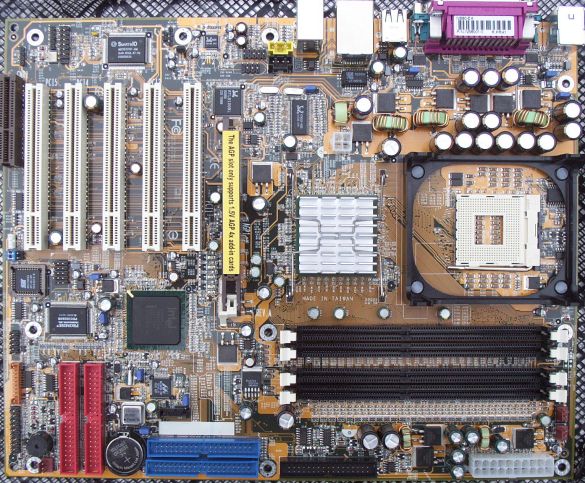Layout and features

Not one to experiment with the growing number of PCB colours that some manufacturers are toying with, the DFI arrives in the generic PCB colour of old. The socket area has enough room to mount an Alpha-class of cooler with comparative ease, I used one in testing. The capacitors on the far side, although close, don't hamper larger coolers.
The signature dual banks of DDR memory, which can be used in either single or dual-channel mode depending upon configuration, leave you with enough room to mount and dismount system RAM with an AGP card inserted into the 8x slot. That's been a problem on a number of previous motherboards. 2 fan headers sit in close attendance. I like the positioning of the main 21-pin ATX power connector; I've always favoured a location that doesn't involve possible airflow disturbance. Similarly, the location of the floppy and standard IDE ports is good. There are 5 LEDs next to the first PCI slot that serve as rudimentary problem-solving devices. They switch on in various combinations which can be cross-checked against the manual if you cannot boot successfully. A small problem is that they're mainly hidden by the AGP card.
A large passive heatsink is given the task of cooling the E7205 Northbridge. As well as using a 4-way attachment, it's also secured to the NB via some form of epoxy. Attempting to remove it was a difficult task. I like passive heatsinks, as most of us are after quiet yet powerful systems.
As is now becoming increasingly common, a lot of the action takes place in the bottom left of the motherboard (as we look at it).

RAID comes in both standard and Serial ATA flavours. Both RAID functions can only be enabled / disabled via the use of on-board jumpers. The more I look at this motherboard the more it reminds me of an Asus effort. They're known for their liking of on-board jumpers.
Standard IDE RAID is provided courtesy of the Promise PDC20265R chip. This one's been around the block a few times, and it's specified on a number of motherboards. Offering RAID 0 and 1 support (no RAID 0+1), and ATA100 support, it can manage up to 4 drives in varying combinations. Strangely, to use a single hard drive, you still have to create a pseudo array. I'm kind of surprised that newer Promise controllers weren't used. I'd take the Highpoint HPT37x series if given a choice.
Serial ATA is managed by the single Marvell 8830 chip and port (max speed 1.5Gbps), but no parallel-to-SATA converter is provided. The ICH4 is still the Southbridge of choice for Intel-based motherboards. The ICH5 will probably debut with the Springdale chipsets scheduled for release early next year.

Ever popular and ever present are the ALC650 sound CODEC and RTL8100BL 10/100 LAN IC. With 'only' 5 PCI slots, the presence of an on-board Ethernet controller makes implicit sense. The sound chip has been seen on a number of motherboards before. It has the ability to support up to 6 channels with the appropriate outputs, as well as S/PDIF in/out, whose headers are amalgamated on to the PCB.

That should look pretty familiar now. The USB ports, as you'll probably know, are fed from the ICH4 SB, thereby having inherent support for USB2.0. A further 2 ports are available via a header on the motherboard itself. With the Granite Bay format natively supporting Hyper-Threading found on the 3.06GHz P4, the DFI NB80-EA is ideally placed to provide a powerful, forward-looking platform for today and tomorrow's P4s.









